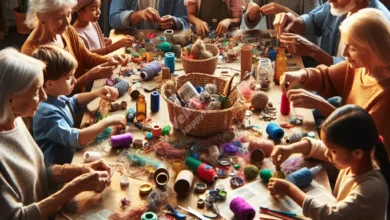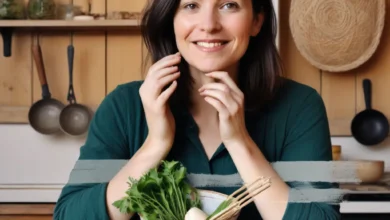Zero Waste Art: Crafting Beauty, Preserving Our Planet

Introduction: Art Meets Sustainability
Art is changing. It’s not just about beauty anymore. Now, it’s also about saving our planet. Artists are finding new ways to create without waste. This is called zero waste art.
Imagine an art show where everything is eco-friendly. The sculptures? Made from old plastic. The paintings? Created with natural colors. Even the gallery itself is green! This isn’t just a dream. It’s happening now, all around the world.
Why is this important? Art can be messy. Many materials artists use are bad for the environment. Think about toxic paints or things that can’t be recycled. But artists are clever. They’re finding new ways to make art that’s good for the Earth.
In this article, we’ll explore:
- How artists are going green
- New techniques that don’t harm the planet
- Challenges artists face when trying to be eco-friendly
- How art can inspire others to care about the environment
Are you an artist? Do you love art? Or maybe you just care about the planet? This article is for you. You’ll discover how creativity and caring for nature go hand in hand.
Get ready to see how art is helping create a cleaner, brighter future. Let’s dive in and explore the colorful world of zero waste art!
Understanding Zero Waste in Art
Zero waste is more than just a buzzword. In the art world, it’s a revolutionary approach to creation. But what does it really mean?
At its core, zero waste in art means creating beautiful works while producing little to no trash. It’s about using materials wisely and finding creative ways to reuse or recycle everything. Artists who embrace this philosophy aim to leave no trace on the environment through their work.
Here’s how zero waste principles apply to art:
- Mindful material selection: Choosing eco-friendly or recycled materials
- Waste reduction: Minimizing scraps and finding uses for leftovers
- Upcycling: Transforming discarded items into art
- Sustainable processes: Using techniques that don’t harm the environment
The idea of eco-friendly art isn’t new. In the 1960s and 70s, the Earth Art movement saw artists using natural materials to create temporary installations. Today, this concept has evolved. Modern zero waste artists not only use natural materials but also tackle environmental issues head-on through their work.
Did you know? Some artists are now creating paints from food waste, sculptures from ocean plastic, and canvases from recycled fabrics. These innovative approaches show how art can be both beautiful and kind to our planet.
By understanding zero waste in art, we open up a world of creative possibilities. It challenges us to think differently about what art can be and how it can positively impact our world.
The Environmental Impact of Traditional Art Practices
Many people don’t realize that traditional art can have a significant environmental footprint. Let’s take a closer look at how common art materials affect our planet.
Common Art Materials and Their Environmental Effects
- Oil paints: Often contain toxic heavy metals and require harmful solvents for cleanup
- Acrylic paints: Made from plastics that don’t biodegrade and release microplastics when washed
- Canvases: Usually treated with chemicals and often not recyclable
- Plastics in sculptures: Can take hundreds of years to decompose
Art Waste by the Numbers
The scale of art-related waste might surprise you:
- Over 12 million pounds of acrylic paint end up in landfills annually in the US alone
- Approximately 20% of art materials purchased by students are wasted
- Thousands of tons of marble and stone are discarded yearly from sculpture production
Artists and Institutions Making a Change
Despite these challenges, many in the art world are taking steps to reduce their environmental impact:
- The Tate Modern, London: Committed to reducing its carbon footprint by 10% each year
- Artist Olafur Eliasson: Creates stunning installations using renewable energy and recycled materials
- The Museum of Modern Art (MoMA), New York: Implemented a comprehensive sustainability plan, including using LED lighting and reducing packaging waste
These examples show that change is possible, even in large-scale art production and exhibition. They inspire other artists and institutions to consider their environmental impact and take action.
By understanding the environmental challenges in traditional art practices, we can better appreciate the importance of zero waste approaches. It’s not just about creating beautiful art – it’s about preserving the beauty of our planet too.
Innovative Zero Waste Art Techniques
Artists are getting creative not just with their art, but with how they make it. Let’s explore some exciting zero waste art techniques that are changing the game.
Upcycling and Repurposing
Upcycling in art means taking old or discarded items and turning them into something beautiful and valuable. It’s like magic – trash becomes treasure!
Examples of artists using found objects or recycled materials:
- Aurora Robson: Creates stunning sculptures from plastic bottles
- El Anatsui: Makes large-scale artworks from bottle caps and metal scraps
- Nick Cave: Designs wearable sculptures from thrift store finds
Tips for aspiring artists to start upcycling:
- Look at everyday objects with new eyes – what could they become?
- Visit thrift stores, flea markets, or even your recycling bin for inspiration
- Experiment with different adhesives and techniques to join materials
- Think about the story behind the materials you use – it adds depth to your art
Biodegradable Art Materials
Many artists are swapping traditional supplies for eco-friendly alternatives. Here’s a quick comparison:
| Traditional Material | Biodegradable Alternative |
|---|---|
| Oil paint | Natural pigments |
| Acrylic | Milk paint |
| Resin | Agar or gelatin |
| Plastic | Bioplastics from algae |
Eco-friendly art supply brands like Natural Earth Paint and Eco-Friendly Crafts are making it easier for artists to go green.
Digital Art and Its Environmental Considerations
While digital art doesn’t create physical waste, it’s not without environmental impact. The energy used by computers and servers contributes to carbon emissions. However, digital art can be more sustainable when done mindfully.
Energy-saving tips for digital artists:
- Use energy-efficient devices
- Turn off equipment when not in use
- Consider using renewable energy sources
- Optimize file sizes to reduce storage and transfer energy needs
By embracing these innovative techniques, artists can create stunning works while minimizing their environmental impact. It’s proof that sustainability and creativity can go hand in hand, opening up exciting new possibilities in the art world.
Zero Waste Art Exhibitions and Galleries
The zero waste movement isn’t just changing how art is made – it’s transforming how it’s displayed too. Let’s explore how galleries and exhibitions are going green.
Eco-Friendly Exhibition Strategies
Smart curators are finding creative ways to showcase art sustainably:
- Using LED lighting to save energy
- Crafting displays from recycled materials
- Implementing digital catalogs instead of printed ones
- Encouraging virtual tours to reduce travel emissions
Successful Zero Waste Art Shows
Some exhibitions are leading the way in sustainability:
- “Waste Age” at the Design Museum, London: Featured art made entirely from waste materials
- “Climate House” at the Royal Botanic Garden, Edinburgh: An ongoing exhibition in a carbon-neutral building
- “Reduce, Reuse, Reimagine” at the Museum of Contemporary Art, Los Angeles: Showcased upcycled art and educated visitors about waste reduction
How Galleries Are Adapting
Art spaces are making big changes to reduce their environmental impact:
- Sustainable building practices: Using eco-friendly materials for renovations
- Waste management: Implementing recycling and composting programs
- Community engagement: Hosting workshops on sustainable art practices
- Ethical partnerships: Collaborating with environmentally responsible sponsors
The Role of Art in Promoting Zero Waste Lifestyles
Art isn’t just adopting zero waste principles – it’s spreading the message too.
Art as Environmental Messenger
Powerful artworks can make people think about waste in new ways. For example, Chris Jordan’s photographs of albatross chicks filled with plastic waste shock viewers into reconsidering their plastic use.
Interactive Installations
Some artists create experiences that teach about waste reduction:
- “The Plastic Bank” by Von Wong: An installation made from recycled plastic that visitors can interact with
- “Waste Land” by Vik Muniz: A project that turned garbage pickers into art subjects, raising awareness about waste and social issues
Artist-Activist Collaborations
Many artists are teaming up with environmental groups to amplify their message. The “Parley for the Oceans” initiative, for instance, works with artists to create pieces from ocean plastic, drawing attention to marine pollution.
By embracing zero waste practices and spreading environmental awareness, the art world is painting a greener future. It shows us that creativity and conservation can work together beautifully, inspiring us all to rethink our relationship with waste.
Challenges and Solutions in Zero Waste Art
Creating eco-friendly art isn’t always easy. Artists face several hurdles when trying to go green. But for every challenge, there’s a creative solution.
Common Obstacles
- Limited materials: Finding sustainable alternatives can be tough
- Higher costs: Eco-friendly supplies often cost more
- Durability concerns: Some sustainable materials may not last as long
- Technique adaptation: Artists need to learn new methods
- Market acceptance: Some buyers may be skeptical of unconventional materials
Innovative Solutions
Artists are finding clever ways to overcome these challenges:
- DIY materials: Making their own paints from natural pigments
- Community resource sharing: Setting up art supply swap meets
- Educating buyers: Explaining the value and impact of sustainable art
- Experimenting with preservation: Developing new ways to protect eco-friendly artworks
- Collaborating with scientists: Partnering to create new, sustainable art materials
Resources for Eco-Conscious Artists
If you’re an artist looking to go green, here are some helpful starting points:
- Art Alternatives: A website listing eco-friendly art supplies
- Green Art Lab Alliance: A network for sustainable art practices
- Sustainable Arts Foundation: Offers grants for artists exploring sustainable methods
- Local waste management facilities: Often allow artists to collect materials for upcycling
Remember, transitioning to zero waste art is a journey. It’s okay to start small and gradually incorporate more sustainable practices into your work.
The Future of Zero Waste Art
As we look ahead, the future of zero waste art seems bright and full of possibilities.
Emerging Trends
- Bioart: Using living organisms in art, like algae or bacteria
- Ephemeral art: Creating temporary installations that leave no trace
- Virtual reality art: Reducing physical waste through digital experiences
- Community-based projects: Engaging local communities in creating sustainable public art
Predictions for the Art World
- Sustainability certifications for art galleries and museums
- Eco-friendly art materials becoming the norm rather than the exception
- Climate-focused curricula in art schools
- Carbon-neutral art fairs and exhibitions
Potential Impact on Art Education
Art schools are likely to integrate sustainability into their programs:
- Courses on eco-friendly art techniques
- Workshops on sourcing sustainable materials
- Emphasis on the artist’s role in environmental stewardship
- Collaborations with environmental science departments
The future of zero waste art is not just about creating beautiful objects – it’s about reshaping our relationship with the world around us. As more artists embrace sustainable practices, they’ll continue to inspire and challenge us to think differently about waste, consumption, and our impact on the planet.
Conclusion: Crafting a Greener Future Through Art
As we’ve explored throughout this article, the merging of art and zero waste practices is more than just a trend – it’s a powerful movement reshaping the creative world.
Let’s recap the key points:
- Zero waste art is revolutionizing how artists create and exhibit their work
- Traditional art practices often have significant environmental impacts
- Innovative techniques like upcycling and using biodegradable materials are gaining popularity
- Galleries and exhibitions are adopting eco-friendly strategies
- Art plays a crucial role in promoting zero waste lifestyles
- While challenges exist, artists are finding creative solutions
- The future of art education and practice is likely to prioritize sustainability
Call to Action
Whether you’re an artist, an art enthusiast, or someone concerned about the environment, you can be part of this exciting change:
- If you’re an artist, consider incorporating zero waste principles into your work
- As an art buyer, support artists who use sustainable practices
- Gallery owners can implement eco-friendly exhibition strategies
- Educators can integrate sustainability into art curricula
- Everyone can spread awareness about the importance of zero waste art
Final Thoughts
The fusion of art and sustainability shows us that creativity knows no bounds. It proves that we can create beauty without compromising our planet’s health. As artists continue to innovate and inspire, they’re not just crafting artwork – they’re crafting a greener future for us all.
By embracing zero waste art, we’re not losing anything. Instead, we’re gaining a whole new world of creative possibilities while contributing to a healthier planet. It’s a win-win situation that proves art can be both beautiful and responsible.
So, let’s pick up that recycled paintbrush, that upcycled canvas, or that digital stylus, and start creating. The masterpiece we’re all working on together is a sustainable, vibrant, and artistic world. And in this masterpiece, every eco-friendly brushstroke counts.
Additional Resources
For those inspired to learn more or start their zero waste art journey:
Books
- “Sustainable Art: A New Philosophy for Art and Design” by Jason Schenker
- “The Zero-Waste Artist” by Andra Watkins
Eco-Friendly Art Supply Stores
- Natural Earth Paint (online)
- Eco-Friendly Crafts (online)
- Green Art Supply (New York, USA)
Upcoming Zero Waste Art Exhibitions
- “Recycle, Reuse, Recreate” – San Francisco Museum of Modern Art (Spring 2025)
- “Earth Canvas” – Tate Modern, London (Summer 2025)
Remember, every small step towards sustainability in art makes a difference. Let’s create, inspire, and pave the way for a greener, more beautiful world!



